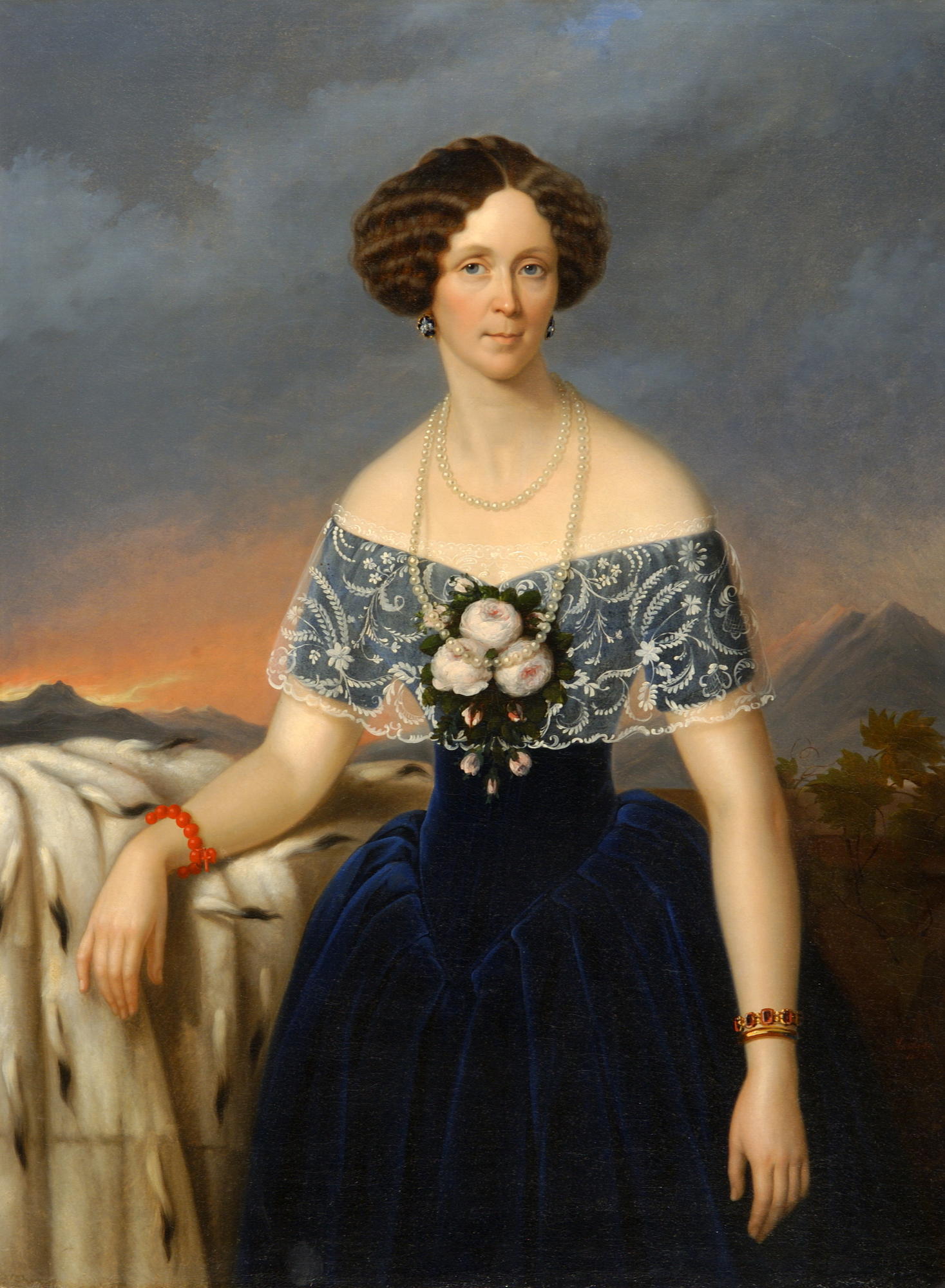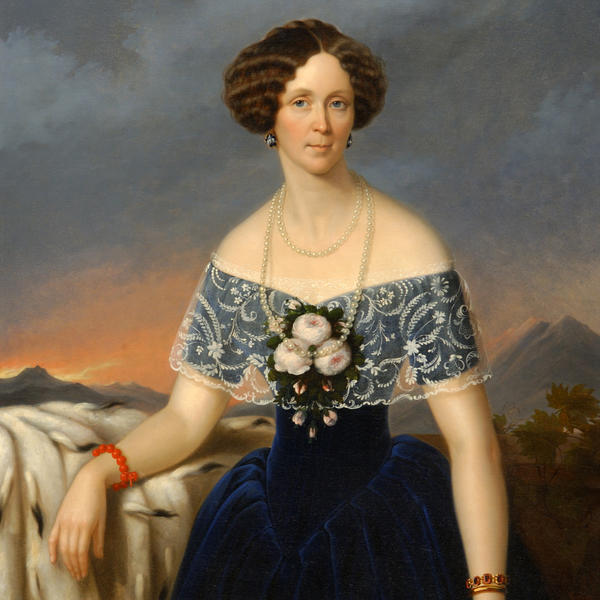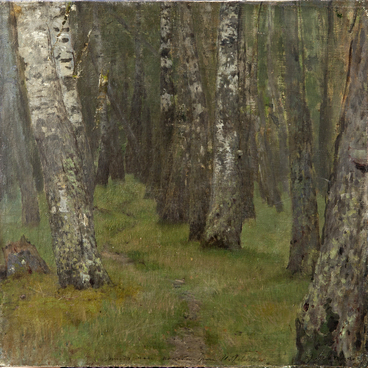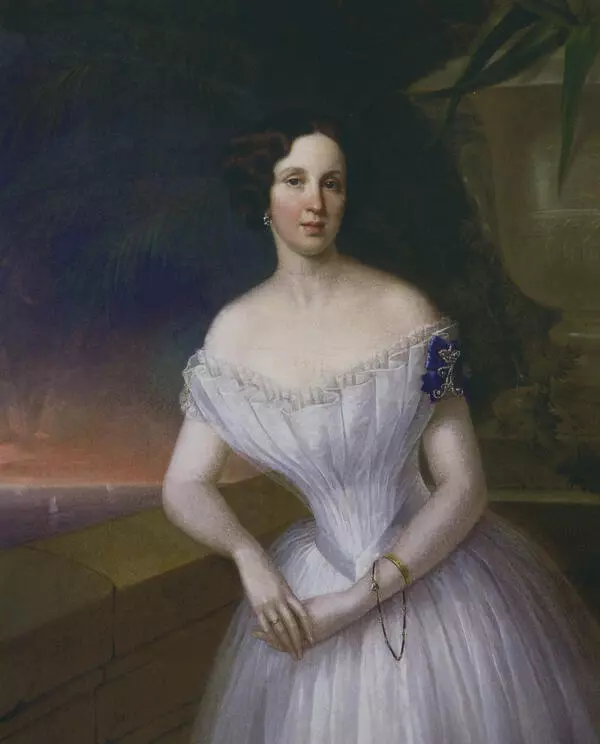Russian painter Gavriil Yakovlev was known in his lifetime as a master of the ceremonial portrait. He graduated from the Imperial Academy of Fine Arts as a free non-class artist. For a long time he worked as a teacher of drawing and sketching, and in 1853 he received the title of academician for the portrait of Professor Fyodor Bruni.
Since 1852, Yakovlev regularly presented portraits at academic exhibitions and performed official orders. He painted a portrait of Nicholas I for the Engineering Department of the War Ministry, and portraits of Emperor Alexander II and his brother, Grand Duke Konstantin Nikolaevich, who headed the Naval Department, for the Kronstadt library.
The painting A Portrait of an Unknown Woman in Blue Dress was made by Yakovlev according to all canons of the ceremonial portrait. The heroine poses against the backdrop of a mountainous landscape, a wide panorama of which stretches behind her. The main background is the evening sky with bright orange flashes of the last sunbeams.
In the composition, Yakovlev used the method of low horizon line, which is typical for the ceremonial portrait and which has been known since the Renaissance. This technique creates the impression that the person on the portrait is above the world and actually reigns in it. The viewer has to look from the bottom up and realize the superiority and greatness of the character. The effect was to make the viewer admire the person on the portrait. Yakovlev’s heroine dominates the space, overshadowing the rest of the world. The artist enlivens the impassioned official image with an unusually emotional background of the sunset sky, which gives the canvas a romantic elevation and spirituality to the model.
Yakovlev masterfully conveyed the texture of the fine lace capella, the heavy velvet of the blue dress, the play of fur in the air and the matte shine of pearls. The features of the woman’s face are painted by him in a vivid manner, but there is a severity and some detachment in them, which do not allow to penetrate into her inner world. The image of a woman is underlinedly secular, Yakovlev supplemented it with a thought-out gesture: the heroine with her right hand leaned on an invisible parapet, on which a cloak of precious ermine is carelessly thrown. This detail indicates that the woman belongs to the royal family.
Researchers assume that the picture depicts the Grand Duchess Maria Nikolaevna, the eldest daughter of Nicholas I. Yakovlev painted this portrait in 1852, when Maria Nikolaevna became president of the Imperial Academy of Arts.
Since 1852, Yakovlev regularly presented portraits at academic exhibitions and performed official orders. He painted a portrait of Nicholas I for the Engineering Department of the War Ministry, and portraits of Emperor Alexander II and his brother, Grand Duke Konstantin Nikolaevich, who headed the Naval Department, for the Kronstadt library.
The painting A Portrait of an Unknown Woman in Blue Dress was made by Yakovlev according to all canons of the ceremonial portrait. The heroine poses against the backdrop of a mountainous landscape, a wide panorama of which stretches behind her. The main background is the evening sky with bright orange flashes of the last sunbeams.
In the composition, Yakovlev used the method of low horizon line, which is typical for the ceremonial portrait and which has been known since the Renaissance. This technique creates the impression that the person on the portrait is above the world and actually reigns in it. The viewer has to look from the bottom up and realize the superiority and greatness of the character. The effect was to make the viewer admire the person on the portrait. Yakovlev’s heroine dominates the space, overshadowing the rest of the world. The artist enlivens the impassioned official image with an unusually emotional background of the sunset sky, which gives the canvas a romantic elevation and spirituality to the model.
Yakovlev masterfully conveyed the texture of the fine lace capella, the heavy velvet of the blue dress, the play of fur in the air and the matte shine of pearls. The features of the woman’s face are painted by him in a vivid manner, but there is a severity and some detachment in them, which do not allow to penetrate into her inner world. The image of a woman is underlinedly secular, Yakovlev supplemented it with a thought-out gesture: the heroine with her right hand leaned on an invisible parapet, on which a cloak of precious ermine is carelessly thrown. This detail indicates that the woman belongs to the royal family.
Researchers assume that the picture depicts the Grand Duchess Maria Nikolaevna, the eldest daughter of Nicholas I. Yakovlev painted this portrait in 1852, when Maria Nikolaevna became president of the Imperial Academy of Arts.





